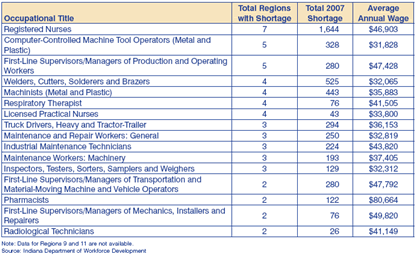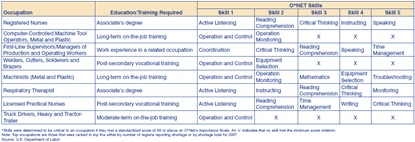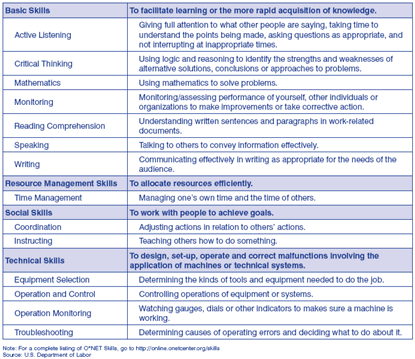Indiana Strategic Skills Initiative
Built with the goal of creating new jobs and raising Hoosier income, the Strategic Skills Initiative (SSI) fights unemployment by going directly to its root causes. It is an initiative of the Indiana Department of Workforce Development, and one of its goals is to identify and alleviate shortages projected to exist in critical occupations and specific skill sets within high-wage Indiana industries. Here are some of the initial findings.
Occupational Shortages
Table 1 lists the high wage occupations that were identified by each of the economic growth regions (EGRs) as having a critical shortage of qualified workers in the next 24 months. Occupations are listed by the number of regions reporting a shortage for the occupation and the total reported shortage by 2007. High-wage occupations are defined as those that have an average wage exceeding the statewide median wage of $27,204 for all occupations in the current Occupational Employment Statistics (OES) survey.
Table 1: High-Wage Occupations with Critical Shortages in Given Occupation
Occupations in the health care services sector were reported as having the largest shortage, including registered nurses (RNs), licensed practical nurses (LPNs) and respiratory therapists. RNs ranked the highest in terms of both the number of regions reporting shortages and the total number of job vacancies expected in the next 24 months. Seven of the nine regions reporting data reported shortages for RNs for a total of 1,644 job vacancies. The only regions not reporting an RN shortage were Region 4 and Region 7. Four regions (2, 7, 8 and 10) reported a shortage for respiratory therapists for 76 job vacancies.
Manufacturing was a close contender with health care services, as the EGRs reported a total shortage of 1,576 for that industry sector. Five regions (2, 3, 4, 5 and 6) reported metal and plastic computer-controlled machine tool operators as having a shortage with a total of 328 job vacancies. Welders, cutters, solderers and brazers possessed the biggest shortage (525 vacancies), while metal and plastics machinists had the second highest at 443.
Of all the occupational shortages reported, pharmacists have the highest annual wage of $80,664. First-line supervisors/managers of mechanics, installers and repairers have the second highest annual wage of $49,820.
New and Emerging Occupations
New and emerging occupations are defined here in two ways. The first is simply a new occupation—one that cannot be adequately described within the existing Standard Occupational Classification (SOC) system. This typically occurs when the tasks and skills required of an occupation do not fit neatly into an existing classification because of fundamental changes in the way things are done in an industry. Industries experiencing technological transformation may warrant new titles and work activities. Secondly, existing occupations may emerge into industries that have developed new technologies and processes requiring already existing occupations within the SOC system, but are new to the changed industry.
The following occupations appear to be emerging into industries where they have not appeared before and were reported as a shortage occupation in at least one EGR. These were found in at least five industries in the latest OES survey for Indiana. (1) None had been reported as existing within those industries in previous surveys. Five industry sectors were predominant in producing these emerging occupations. Those five are manufacturing, retail trade, wholesale trade, information and finance and insurance. Manufacturing is the number one sector for these emerging occupations by far. All listed occupations, except dispatchers, were newly found in at least one manufacturing industry.
Emerging Occupations:
- Compliance officers (except agriculture, construction, health and safety, and transportation)
- Compensation, benefits and job analysis specialists
- Management analysts
- Computer support specialists
- Computer systems analysts
- Sales representatives, wholesale and manufacturing (except technical and scientific products)
- Dispatchers (except police, fire and ambulance)
- Bus and truck mechanics and diesel engine specialists
- Fabric menders (except garment)
- Cutting, punching and press machine setters, operators and tenders (metal and plastic)
- Packaging and filling machine operators and tenders
- Cleaners of vehicles and equipment
Bridging Occupations to Skills in Demand
Region 6 identified emerging occupations within an emerging
industry - Agribusiness (farming as a large-scale business operation combining
the production, processing and distribution of agricultural products and
the manufacture of farm machinery, equipment and supplies). By seeking
and receiving feedback from local industry experts on technological advancements
in biofuels and value-added research, Region 6 was able to identify life
scientists and business operations specialists as emerging occupational
groups that are expected to grow. Skills that will need to be cultivated
in order to fill expected shortages can be identified by looking at the
Department of Labor's O*NET classification of skills by occupation. The
five most common critical skills for life scientists are science, reading
comprehension, critical thinking, active learning and writing. For business
operations specialists, critical skills include speaking, reading comprehension,
active listening, critical thinking and writing. A complete listing of
O*NET skills and corresponding definitions is available at
http://online.onetcenter.org/skills.
Top Five Skills for Indiana's Top Occupations
Education and training required for Indiana's top occupations include a mix of on-the-job training and post-secondary education. Top occupations in the health care services sector require at least an associate's degree while most occupations in manufacturing require moderate to long-term on-the-job training. Critical skills required for health care services occupations include active listening, reading comprehension, critical thinking, instructing, speaking, writing, time management and monitoring (see Table 2).
Table 2: Critical Training and Skills Required to Perform Occupational Functions*
In contrast, critical skills for manufacturing include operation and control, equipment selection, mathematics, troubleshooting, and operation monitoring. First-line supervisors/managers of production and operating workers was closely aligned with skills required of occupations in health care services to include coordination, critical thinking, reading comprehension, speaking and time management. Table 3 describes these high-demand skills.
Table 3: Description of Skills in Highest Demand
Addressing Skill Gaps
As Indiana's economic growth regions proceed with determining root causes and solutions during subsequent phases of SSI, emphasis should be made on 1) the relationship between emerging high demand/high wage occupations and the skills associated with those occupations, 2) developing career pathways, and 3) bridging the gap between supply and demand of qualified workers.
Addressing the root causes for skill shortages and developing sound solutions will be contingent on the ability of the regions to foster coalitions between industry partners, education institutions and organizations that provide supportive services to job seekers who wish to develop those skills in need. The accuracy of identifying root causes and the quality of the solutions to address these skills gaps are critical to Indiana's economic health and competitive business survival.
Notes
- The OES survey date referenced for Indiana emerging occupations is May 2004.
Hope Clark, Director,
Research and Analysis,
and Jon Wright, Advanced
Economic and Market Analysis
Indiana Department of Workforce
Development



